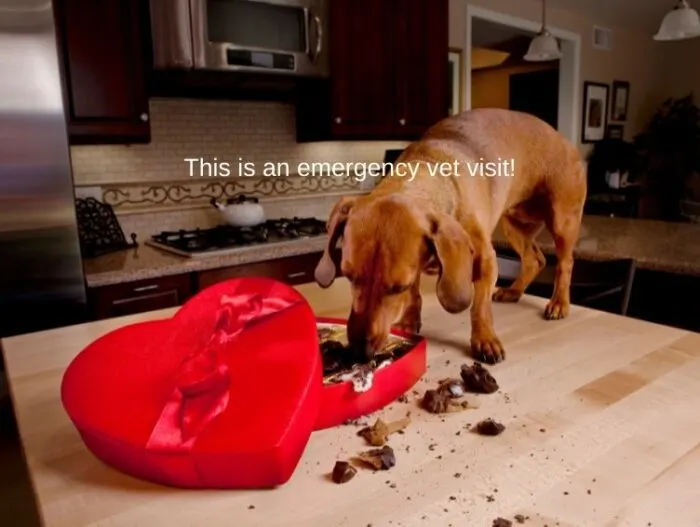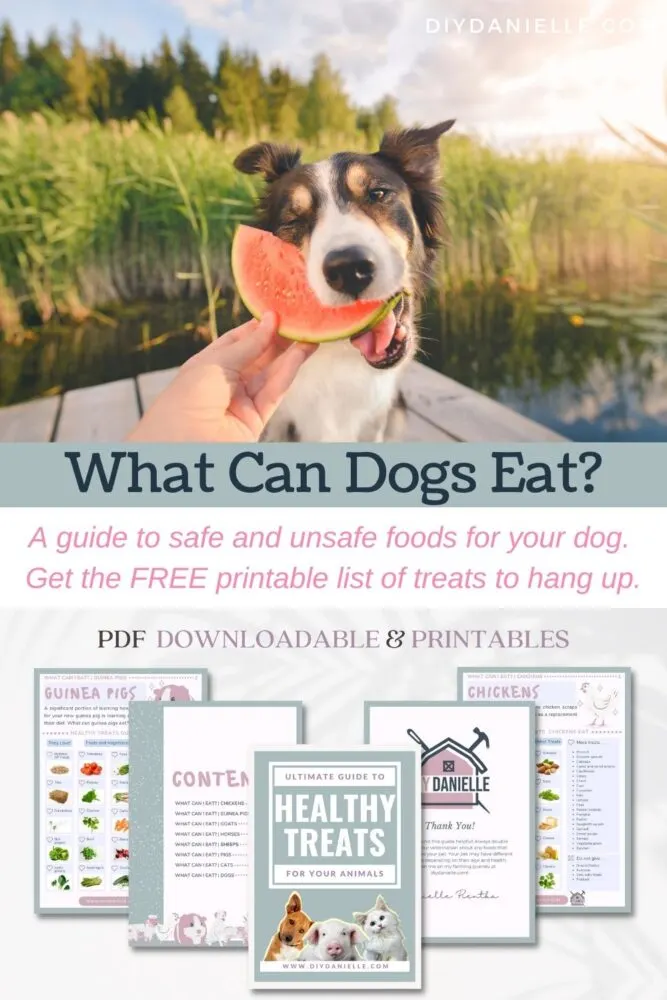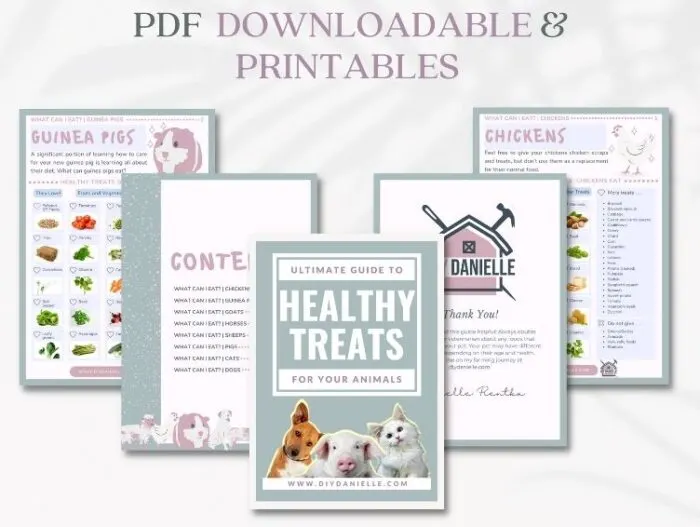What Can Dogs Eat? Here’s a guide to foods that are safe or toxic for your pup, as well as a printable list of safe treats!
They’re friendly, loyal, and undeniably cute: Man’s Best Friend has truly earned the title over the thousands of years that canines have stood by our side. The (mostly) carnivorous wolves that once roamed the earth have been domesticated into the precious pups we know and love today, and along the way their digestive systems have adapted to suit the lifestyles of their human masters. Being a dog owner comes with a host of responsibilities, not the least of which is making sure they are fed a quality diet.
Taking care of your dog’s dietary needs doesn’t need to be a huge undertaking. By following these few simple guidelines, you’ll master the care and feeding of your furry friend in no time.
This post may contain affiliate links which may earn me commissions should you click through them and take certain actions. As an affiliate for Amazon, Cricut, xTool, Home Depot, and other sites, I earn from qualifying purchases. Please DIY carefully. View my full legal disclosures here.
Please read the whole post so you don’t miss any important information!
What Can Dogs Eat?
Commercially Sold Dog Food
You may think you already know everything there is to know about dog food, but the subject can be more complicated than it seems. For example, dogs are omnivores and their dog food should reflect that–meat should be high on the ingredient list (within the first few ingredients) with a balance of vegetables and grains not far behind. Read the ingredient list and be on the lookout for fillers, artificial colors and flavors. Things like corn syrup, flour, unlabeled “meat products”, nitrates, nitrites, and vegetable oil are typical indicators that a pup’s food isn’t up to par. This also goes for wet food. If you prefer to feed wet, make sure that you pay attention to expiration dates, as wet foods usually have a shorter shelf life than dry food.
Dogs of different sizes and breeds have different nutritional needs. Make sure your dog is on a food that caters specifically to their size, breed, activity level, and stage of life. Puppies need a different formula than matured pups and senior canines. In between stages (or any time you change food brands or formulas) gradually facilitate the transition by exchanging a small percentage of the old food for the new formula over a week until you’re feeding only the new food. Administer feed throughout the day at a volume and frequency that is appropriate for your pooch.
When trying a new food, keep an eye out for the telltale signs of allergic reaction: itchy skin, welts or hives, redness, watery eyes, weight loss, lethargy, vomiting, loss of appetite, and digestive upset. Dogs with health issues can be prescribed medicated diet formulas to address specific concerns. You’ll know your dog is on the right diet when they’re maintaining a healthy weight and have a shiny coat, plenty of energy, and regular bowel movements.
When in doubt, check to make sure the feed is endorsed by the Association of American Feed Control Officials (AAFCO) by looking for a statement on the label or doing a quick internet search. AAFCO maintains strict guidelines for balanced pet nutrition, making it easy to tell the junk foods from the more wholesome brands at a glance.
Supplements
You may find the need to add supplements to your daily feeding routine to suit your dog’s lifestyle. Examples of popular supplements include probiotics for digestion, glucosamine for joint support, fish oil to reduce inflammation, and doggie multivitamins for general health. Make sure you’re obtaining your supplements from a reputable source and administering them according to the exact dosing instructions for your dog’s age and weight. Stay vigilant for adverse reactions and alert your veterinarian immediately if you notice your pup acting strange after starting a supplement.
Treats
All of the guidelines listed above for dog food apply to treats as well! Treats should contain high-quality meats, grains, and vegetables. Store-bought treats are often highly processed and contain things like artificial colors, preservatives, and added sugar. When purchasing treats, make sure they are made from ingredients that you can recognize and pronounce. If you’re worried about finding suitable treats, you can always make your own from a few simple ingredients. If you’re not the baking type and prefer the convenience of a readily available treat, fruits and vegetables make a great alternative to conventional dog treats.
Fruits and vegetables
Here’s something many people don’t know: dogs can have (and love!) fruits and vegetables in moderation! Fruits and veggies for your pup have all kinds of benefits, from helping them maintain a beautiful, pearly white smile to providing antioxidants needed to keep them feeling their best. Offer different produce to provide a full range of nutrients and have fun discovering which ones are your pet’s favorite. Veggies should be offered sparingly as snacks once a day and fruits should be limited to a few times a week due to higher sugar content.
Make sure that fruits have harmful seeds and pits removed as well as any choking hazards like hard stems. Cut down large pieces into easy-to-chew sizes and monitor every time they’re offered in case you need to intervene.
Here are a few of the fruits and veggies that are totally okay to feed your canine companion:
- Apple slices (seeds removed)
- Banana slices
- Blueberries
- Cranberries
- Strawberries
- Raspberries
- Melon slices (seeds removed)
- Pear slices
- Pineapple pieces (rind removed)
- Kiwis
- Peach slices (pit removed)
- Cucumber
- Broccoli
- Carrots
- Pumpkin
- Zucchini
- Green beans
- Sweet potato
- Peas
- Beets
- And more!

Toxic Foods for Dogs
Not all fruits and veggies are created equal. Though there are many produce items they can have, there are many that are absolutely off-limits for your house hound. The following can cause severe reactions or injuries in your canine, ranging in severity from moderate digestive issues to death. Keep a list handy and if you should ever question if something is safe for your dog, the rule of thumb is to assume it’s toxic or otherwise dangerous. Better to disappoint them temporarily than to lose them permanently.
Never let your dog ingest:
- Avocados
- Alliums (onions, garlic, leeks, shallots, chives, etc)
- Alcohol
- Artificial sweeteners (especially xylitol)
- Chocolate
- Caffeine
- Cooked bones
- Grapes/raisins
- Macadamia nuts
- Salt
Should your dog ever consume anything on this list, contact your veterinarian immediately for medical advice and continue to monitor your dog for signs of distress. This list is not exhaustive and there may be other things in your environment that could pose a threat to your dog’s health (not to mention potential undiscovered allergies) so always proceed with caution when introducing something new.
There are quite a few houseplants, as well as plants or weeds in your yard, that may also be toxic to dogs. While animals generally avoid toxic items, it’s best to keep them out of your pet’s reach in case they decide to be adventurous.
I still remember (with horror) the time that my dog Rocky grabbed a closed container of Gorilla Glue off the middle of the kitchen counter and ate it. It’s extremely toxic, and even if they don’t swallow it, it’s impossible to get off fur.
My brother’s tiny pocket-size dog ate an entire bulb of garlic and lived to tell the tail (pun intended), but it’s best to seek vet intervention immediately regardless of what your dog’s size or how much toxic food they ate.
There are dogs who eat a tiny piece of chocolate and die, while others ingest massive amounts of a toxic food and are absolutely fine. But if you wait too long to seek medical help, it may be too late. If you suspect your dog ate something toxic, contact your vet or call the ASPCA Animal Poison Control Center at (888) 426-4435.

Looking for more tips on taking care of your canine pal? Check out DIY Dog Projects on DIYDanielle.com!
I have a printable bundle of foods for different farm animals and household pets. Subscribers can get the printable FREE by signing up below!
Please share and pin this post! If you make this project, share it in our Stuff Mama Makes Facebook Group. We have regular giveaways for gift cards to craft stores. You can also tag me on Instagram @doityourselfdanielle; I love seeing everything you make!

Google Web Story: Pet Organization Ideas

